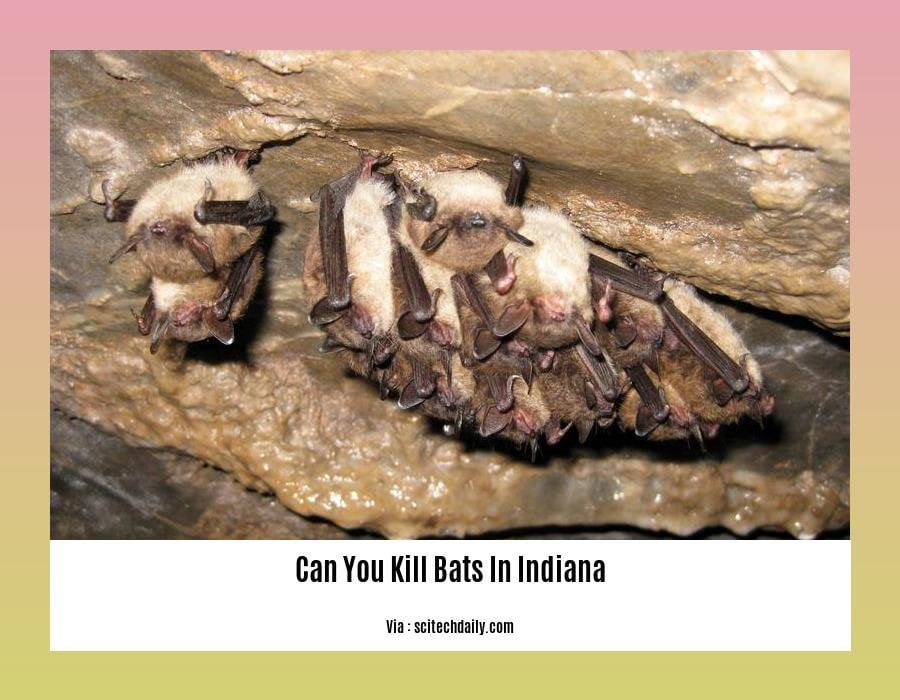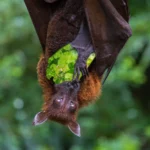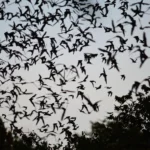Bats, with their echolocation abilities and insect-heavy diet, are intriguing creatures that occasionally decide to share our living spaces. Although we appreciate their natural pest control services, cohabitating with bats can raise concerns. Before addressing any bat presence in your Indiana home, it’s essential to familiarize yourself with the relevant laws and ethical considerations surrounding bat control. This article will delve into the legal aspects and provide insights on how to handle bat encounters responsibly, ensuring both your safety and the well-being of these crucial members of our ecosystem.

Can You Kill Bats in Indiana?
When it comes to bats in Indiana, these small mammals carry significant weight as they are classified as endangered, both at the state and federal levels. This classification translates to stringent regulations regarding their treatment.
In simple terms, killing bats in Indiana is against the law. This prohibition extends beyond direct methods like swatting; it encompasses any action that causes harm, including trapping, injuring, or even possessing a bat without proper authorization. Violating these regulations could result in legal repercussions, potentially leading to fines or other penalties.
Why are bats protected? Indiana bat populations have experienced significant declines due to human disturbance of their hibernation sites, primarily caves. Conservation efforts aim to minimize disturbances to these crucial hibernacula and aid population recovery.
What if a bat finds its way into your house? First and foremost, remain calm. The recommended course of action is to contact a professional animal control service. These experts are equipped to handle the situation safely and legally, ensuring the bat’s well-being and your peace of mind.
Important Note: While killing bats is generally prohibited, a limited exception exists in cases of self-defense. If a bat physically attacks you or there’s a strong suspicion of rabies, you might be permitted to take action to protect yourself. However, it’s always advisable to contact animal control first. They can provide guidance and ensure all actions comply with regulations.
Is it illegal to kill a bat in your house in Indiana?
Picture this: A bat has found its way into your Indiana home. It’s important to remember that these small creatures play a vital role in our environment. They act as natural pest control agents, consuming vast quantities of insects that could otherwise harm crops and forests. However, having them as houseguests is understandably unsettling. This raises the question: Can you legally get rid of a bat in your house in Indiana? The straightforward answer is no, killing a bat in your house in Indiana is illegal.
This is because bats are protected under the Endangered Species Act, a federal law with jurisdiction across the US. Moreover, Indiana has its own state laws that prohibit harming bats. These laws exist to safeguard declining bat populations and maintain the ecological balance they contribute to.
Encountering a bat in your living room is undoubtedly disconcerting. However, instead of resorting to permanent solutions, it’s crucial to seek professional assistance. Your local wildlife officials or licensed animal control experts possess the knowledge and expertise to safely and humanely remove the bat from your home. Their role is to ensure the bat’s relocation to a more suitable habitat.
Here’s a quick overview of the legal status of bats in Indiana:
| Bats in Indiana | Protected by Law? |
| Are federally endangered | Yes |
| Are protected by Indiana state law | Yes |
| Can be legally harmed or killed | No, except in specific situations with permits |
| Should be removed by homeowners | No, contact wildlife officials or animal control |
To summarize: While bats can be intimidating, their ecological contributions and protected status necessitate responsible and humane treatment. Should you encounter a bat in your home, resist any urge to harm it. Instead, contact the appropriate authorities and allow trained professionals to handle the situation.
Can two tortoises live together? Find out if it’s possible and what factors you need to consider before introducing them. can two tortoises live together
Can you legally kill Canadian geese in Florida? Discover the regulations surrounding the control of Canadian geese population in the state. can you kill Canadian geese in Florida
Wondering if you can take action against geese in Ohio? Learn about the laws and methods for managing geese populations in the state. can you kill geese in Ohio
Interested in owning an alligator snapping turtle in Texas? Explore the guidelines and requirements for keeping this unique reptile as a pet. can you own an alligator snapping turtle in Texas

Are Bats Protected in Indiana?
The answer is a resounding yes! Bats in Indiana hold a unique status as endangered species, affording them legal protection. These protections aim to safeguard their populations and ensure their continued presence in the state’s ecosystem. Harming, capturing, or even disturbing a bat or its roosting site could have legal consequences.
The significance of bats stems from their vital role in the environment. These nocturnal creatures are often referred to as “keystone species” because their presence influences the health and stability of entire ecosystems. One of their most notable contributions is insect control. Bats consume massive quantities of insects, many of which are considered agricultural or forest pests. By keeping these insect populations in check, bats provide a valuable service, reducing crop damage and promoting healthy forests.
Caves serve as crucial hibernation sites for bats, providing them with a safe and stable environment during the winter months. These periods of inactivity are essential for bats to conserve energy and survive harsh weather conditions. However, human activities, such as cave exploration or disturbance, can have detrimental effects on hibernating bats. Disruptions to their hibernation can deplete their energy reserves, making them vulnerable to starvation or disease.
If you discover a bat in your attic, it’s crucial to avoid direct contact or attempts to handle it. Instead, contact your local animal control or wildlife agency. These professionals are trained to safely and humanely remove bats from homes and other structures. They will also be able to advise you on any necessary precautions to prevent future encounters.
In certain situations, such as when a bat exhibits unusual behavior like daytime activity or aggression, it might be necessary to proceed with caution. These behaviors could indicate illness, including the possibility of rabies. In such cases, contacting animal control immediately is paramount. They can assess the situation, provide appropriate guidance, and, if necessary, test the bat for rabies.
In conclusion, bats in Indiana are protected for a reason. They face numerous threats, including habitat loss, disease, and human disturbance. By understanding and respecting their protected status and ecological importance, we can contribute to their conservation and ensure their continued presence in our state’s rich biodiversity.
Why is it illegal to kill bats in the US?
You’ve landed on this article because you’re curious about the special treatment our winged friends, the bats, receive in the US. It might seem strange that you can’t simply remove them if they become a nuisance. The rationale behind this protection boils down to several factors: robust legal frameworks, the indispensable ecological roles bats play, and fundamentally, it’s the ethical approach.
Let’s break it down. Firstly, the Endangered Species Act (ESA) acts as a safeguard for plants and animals facing extinction. Several bat species, like the Indiana bat, fall under its protection, rendering any harm, capture, or even disturbance illegal without special permits. The ESA carries serious weight, and violations can result in substantial fines or even imprisonment. Further bolstering these protections, many states have enacted their own laws mirroring the ESA, providing an additional layer of safeguarding for these winged wonders.
Beyond legal ramifications, bats, while not always the most aesthetically pleasing, are ecological superheroes. These incredible insectivores possess an insatiable appetite for insects, consuming vast quantities that would otherwise wreak havoc on crops, forests, and our general well-being. Essentially, they provide a free, natural pest control service. By keeping insect populations in check, bats contribute significantly to agricultural productivity and forest health. Moreover, not all bats solely consume insects; some species play crucial roles as pollinators, flitting from flower to flower, facilitating plant reproduction much like bees, but with their own unique sonar-guided approach.
Ethic also factors into bat protection. Bats often bear the brunt of negative stereotypes, portrayed as harbingers of disease or creatures to be feared. The reality is, they are simply trying to survive like any other species. As members of the animal kingdom, they deserve respect and compassion. Unnecessary killing disrupts the delicate ecological balance and raises ethical concerns about animal cruelty.
So, how do we manage conflicts with bats without resorting to lethal measures? Thankfully, several humane and effective methods exist. Exclusion involves “bat-proofing” your home, sealing any cracks, gaps, or holes that might serve as entry points for these tenacious creatures. It’s like gently encouraging them to find alternative accommodation.
Relocation requires a professional touch. Trained wildlife experts, equipped to handle bats safely and humanely, can remove them from your property and relocate them to more suitable habitats. Think of it as providing a one-way ticket to a bat-friendly resort.
Lastly, habitat modification focuses on making your property less appealing to bats. This may involve removing potential roosting spots or creating alternative habitats elsewhere, such as bat houses. These specially designed boxes provide safe and inviting shelters, encouraging bats to take up residence away from human dwellings.
In conclusion, while encountering a bat in your home can be unnerving, it’s crucial to remember their ecological significance and the reasons behind their legal protection. They are fascinating and crucial components of a healthy environment. By understanding why killing them is prohibited, we can collectively contribute to their conservation, ensuring their survival for generations to come.
Key Takeaways:
- Killing bats in the United States is generally illegal, thanks to legislation like the ESA and various state regulations.
- Bats are protected because many populations are endangered, and they play a vital role in maintaining a balanced ecosystem.
- Humane and effective methods like exclusion, relocation, and habitat modification provide alternatives to lethal bat conflict resolution.
- Like all living creatures, bats are deserving of respect and protection. They are not merely creatures of the night; they are essential contributors to a healthy planet.
How to Get Rid of Bats in Indiana?
So, you’ve got bats. It happens! While these creatures are essential for Indiana’s environment, devouring pesky insects that plague crops and trees, having them move into your house is less than ideal, not to mention unnerving.
Before devising an eviction plan, remember the golden rule in Indiana: no harming bats! These protected species require humane treatment.
Think Like a Bat, Outsmart a Bat
The Indiana Department of Natural Resources (DNR) offers practical advice on evicting these unwanted guests without causing harm. Here’s the strategy:
- Seal the Deal (Exclusion): Bats are masters at exploiting tiny openings. Inspect your home like a detective, searching for any cracks, holes, or gaps that might serve as entry points. Once located, seal them up tight. Consider it bat-proofing your fortress.
- One-Way Ticket Out (Eviction): Imagine a door that only swings one way. Special one-way doors or tubes strategically placed at entry points allow bats to exit for their nightly feeding forays while preventing their return. Problem solved!
- Home Makeover (Habitat Modification): Sometimes, bats get a bit too comfy, establishing roosts near homes. This could be in an old tree, a shed, or even parts of your house. Modifying the environment, such as removing attractive roosting sites, can encourage them to relocate.
When to Call in the Pros
Let’s be realistic. Dealing with a few bats is one thing, but a full-blown infestation requires professional intervention. A licensed animal control professional is your best bet if:
- You’re facing a large bat colony.
- Bats have decided the interior of your home is cozier than the great outdoors.
These pros possess the knowledge, experience, and tools to safely remove bats and implement measures to prevent their return.
The Bottom Line
Bats contribute more good than harm to the ecosystem, but that doesn’t mean you have to accommodate them in your living space. With patience, humane methods, and knowing when to call for reinforcements, you can evict those bats while remaining a friend to these flying, insect-devouring allies.
What happens if you kill a bat?
Let’s address the elephant in the room: harming a bat, especially in a place like Indiana where they enjoy protected status, is a serious no-no. Why? These small, often misunderstood creatures play a crucial role in maintaining a balanced and healthy environment.
Think of bats as miniature superheroes of the night, silently patrolling the skies and consuming vast quantities of pesky insects. Mosquitoes, moths, and even agricultural pests are on their menu. Eliminating bats could have unintended consequences, potentially leading to population explosions of these insects. This could mean more itchy bites for us, increased crop damage, and a higher likelihood of insect-borne diseases spreading. Nobody wants that.
From a legal standpoint, killing a bat can result in serious consequences. Laws like the Endangered Species Act in the US exist to protect these animals, many of which already face threats to their survival. Violating these laws can lead to hefty fines and even jail time. It’s simply not a risk worth taking.
What if you encounter a stubborn bat that refuses to vacate your property? Avoid taking matters into your own hands. Call in the professionals! Wildlife removal services employ trained experts who can safely and humanely relocate bats without causing harm or breaking any laws.
Think of it this way: attempting to resolve a bat issue yourself is akin to fixing a leaky pipe without any plumbing experience. It’s always best to leave it to the qualified professionals with the right tools and expertise.
To summarize:
- Bats are beneficial: They act as natural pest control agents, safeguarding our environment and food sources.
- Killing bats is harmful: It’s illegal, detrimental to the ecosystem, and could result in legal trouble.
- Call in the experts: For bat-related issues, contact a professional wildlife removal service – they’re the real bat whisperers.
Is it bad luck to kill a bat in your house?
Let’s be honest: finding a bat swooping around your living room is enough to send chills down anyone’s spine. It’s like a scene straight out of a horror movie. But before you grab the nearest object with the intention of becoming a self-proclaimed vampire hunter, let’s address why harming these creatures is wrong on multiple levels.
Firstly, in many places, including Indiana, harming or killing bats is against the law. It’s not simply about bad luck; it’s about protecting species crucial to a healthy environment. Bats act as natural pest control, consuming vast numbers of insects and keeping their populations in check.
Should you find yourself the unwilling host of a bat in your home, resist the urge to handle it yourself. Call in the professionals! Licensed wildlife removal specialists are equipped to safely relocate bats without causing harm to the animal or yourself.
Preventing these bat encounters in the first place is always the best approach. Fortunately, measures can be taken to make your home less hospitable to these flying visitors. Bat-proofing your house by sealing cracks and holes in its exterior is akin to locking the doors and windows. Covering chimneys and vents with screens adds another layer of protection. By making your home less accessible, you’re gently encouraging bats to find alternative roosting sites.
Numerous myths and misconceptions surround bats. By understanding their ecological importance and treating them with respect, we can coexist peacefully. Who knows, having a few bats around your property could even be beneficial in keeping those pesky mosquitoes at bay!
What if a bat dies in your house?
Discovering a lifeless bat in your home is an unpleasant experience, and you’re likely wondering about the next steps. While bats are fascinating, they can carry diseases, making it crucial to take precautions to protect yourself.
The Golden Rule: Never touch a dead bat directly. Remember those rubber gloves tucked away under your sink? Now’s the perfect time to use them. If gloves aren’t readily available, a sturdy container will work. Carefully scoop the bat into the container and seal it tightly. A simple plastic container or a robust box will suffice.
Now, what to do with your unexpected “guest.” Contact your local animal control or wildlife agency. These experts are well-equipped to handle such situations and can provide specific instructions on how to dispose of the bat safely based on local regulations.
Our understanding of bats and the potential risks associated with them is an ongoing process. While some experts suggest the risk of contracting a disease from a bat is relatively low, erring on the side of caution is always prudent. Contacting your local wildlife agency not only ensures responsible disposal but also provides valuable data for research and conservation efforts. You indirectly contribute to the understanding and protection of these fascinating creatures.
What to do if a bat enters your house?
Finding a bat inside your home can be alarming, but there’s no need to panic. Bats are generally timid creatures, more afraid of you than you are of them. Remember, in Indiana, they are a protected species, so no bat-swatting allowed!
Your first move? Attempt to contain the bat. Turn off lights and fans as these can disorient the animal. Close the door to the room where the bat is located to prevent it from exploring your entire house. Since bats are attracted to open air, open a few windows and doors in the room. There’s a good chance it will find its own way out.
What if the bat decides to hang around, perhaps hoping for a snack? If you have a thick towel or blanket, you can try to gently capture it. Drape it over the bat, carefully scoop it up, and escort your unexpected guest outdoors.
You might be wondering why using a hard container like a coffee can isn’t recommended. Bats are delicate creatures, and using something rigid could cause injury. Towels or blankets provide a much gentler approach.
Bats, despite their sometimes-creepy reputation, play a valuable role in our ecosystem. They consume vast quantities of pesky insects, making them beneficial to humans. So, next time you encounter a bat, remember it’s more of a helpful neighbor than a scary monster.
Can I go to sleep with a bat in my house?
Let’s be real: discovering a bat fluttering around your living room isn’t exactly conducive to a restful night’s sleep. It’s enough to send most people running for cover! But is ignoring the situation and hoping for the best the right course of action? The short answer is a resounding “no.” Here’s why:
Firstly, in many regions, including Indiana, bats are protected. Harming them is against the law without special permission. So, taking matters into your own hands is not advisable.
Secondly, and perhaps more importantly, bats, although they might appear fascinating in a spooky sort of way, can carry diseases. While the risk of contracting a disease from a bat is considered relatively low, it’s always better to be safe than sorry.
If you wake up to find a bat as an unexpected houseguest, resist the urge to handle it yourself. Instead, take a deep breath and follow these steps:
- Remain Calm: This is easier said than done, but try to avoid panicking or chasing the bat.
- Contain the Bat: Close all the doors and windows in the room where the bat is located.
- Provide an Escape Route: Open a window in that room to give the bat a chance to fly out on its own.
- Give the Bat Space: Leave the room and allow the bat to calm down and find its own way out.
- Call in Professionals: If the bat persists in its visit, contact a wildlife removal expert. They can safely relocate your unexpected guest.
Prevention is always the best medicine. Here are a few ways to discourage bats from taking up residence in your home:
- Seal Cracks and Gaps: Bats are masters at squeezing through tiny spaces. Thoroughly inspect and seal any cracks or holes, no matter how small.
- Cap Your Chimney: Installing a chimney cap is an effective way to prevent bats from using it as an entry point.
- Think Like a Bat: Consider installing bat houses around your property to provide alternative roosting sites away from your home.
Our understanding of bats is constantly evolving. Scientists are continuously learning more about these fascinating creatures. If you’d like to delve deeper into the world of bats, explore the resources available from your local wildlife agency or organizations like Bat Conservation International. You might be surprised by how incredible these nocturnal neighbors truly are!
Is it illegal to kill a bat in your house in Illinois?
Let’s say you find yourself facing a bat situation in your Illinois home. The first rule of thumb is you can’t simply get rid of it. Illinois law, specifically the Illinois Wildlife Code, protects bats, meaning you generally cannot legally harm, trap, or even relocate them without a valid reason. This protection underscores the significant role bats play in the environment.
However, a few exceptions exist to this “no harm” policy. If a bat poses an immediate threat—for instance, direct contact with you or a pet—you might be able to justify taking action to protect yourself. However, even in such situations, attempting to scare the bat away is always preferable to resorting to lethal measures. Remember, bats can carry rabies, so avoiding direct contact is crucial. If you must handle a bat, contact the Illinois Department of Public Health for guidance on safety precautions and potential risks.
If you’re dealing with bats in the attic, your best bet is to make your home less appealing to these winged creatures. Sealing up any cracks, holes, or other potential entry points can deter bats from entering your living space. However, this is a task best left to professionals, as improper sealing could trap bats inside. Speaking of professionals, if you require bat removal, contact a licensed wildlife control expert. These individuals possess the necessary expertise and permits to trap and remove bats humanely and legally. They can also provide advice on preventing future encounters.
Here’s a fact you might find interesting: bats are often considered unsung heroes of the ecosystem. They consume massive quantities of insects, providing a valuable service to farmers and gardeners. Furthermore, some bat species act as pollinators, contributing to the health and diversity of plant life, which is essential for our food supply. So, the next time you encounter a bat, remember these often-misunderstood creatures play a vital role in maintaining a balanced ecosystem.
For more information on bats in Illinois, the Illinois Department of Natural Resources website is an excellent resource. You might be surprised by what you learn!
Key Points:
- Killing bats is illegal in Indiana: Bats are protected by both state and federal laws due to their endangered status.
- Protected activities: It is illegal to kill, harm, trap, or possess bats without proper authorization.
- Reason for protection: Indiana bats rely on undisturbed caves for hibernation, which human activities have historically disrupted.
- Bats in the home: If you have a bat infestation, contact an animal control service for safe and legal removal.
- Exception: Bats may be killed in self-defense if they attack or are suspected of having rabies, but it’s always advisable to consult animal control first.
Additional Insights:
- Importance of Habitat Preservation: The article could further emphasize the crucial role of preserving Indiana bat habitat, particularly hibernacula (caves and mines), which are essential for their survival.
- Education and Outreach: Highlighting the role of education and outreach programs in promoting awareness and encouraging responsible bat interactions with the public can foster coexistence.
- Challenges and Controversies: The article could delve into the complexities surrounding endangered species protection, balancing human safety concerns with conservation efforts, and addressing potential conflicts.















